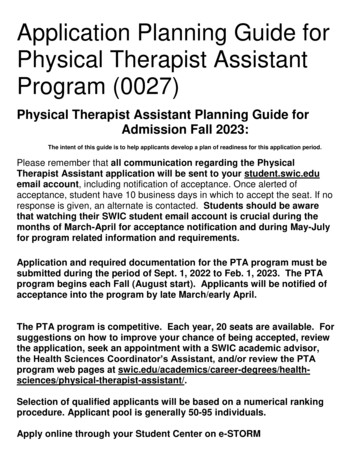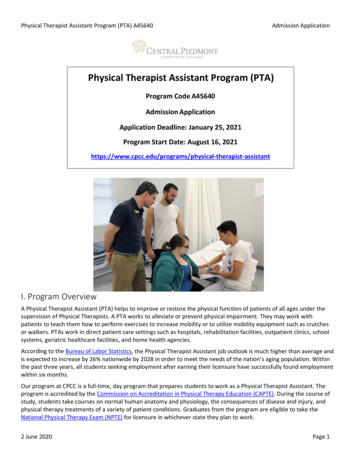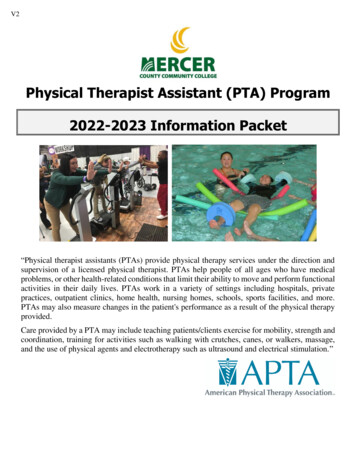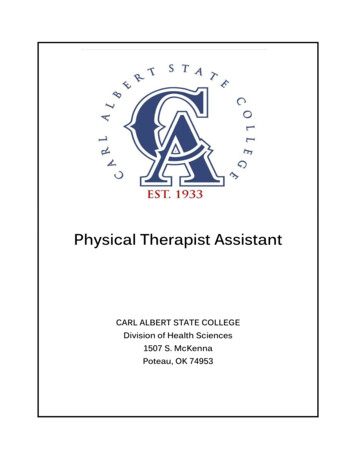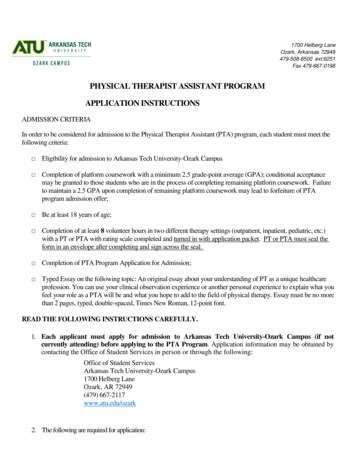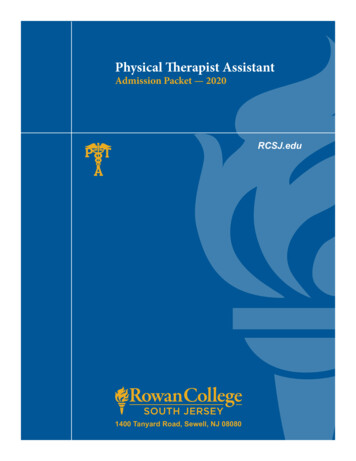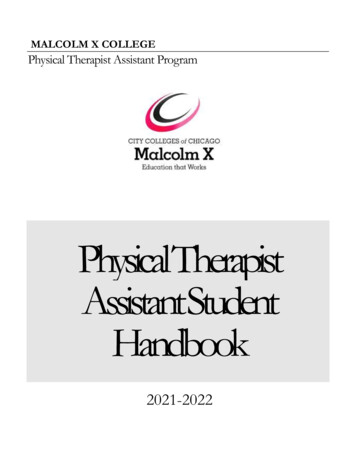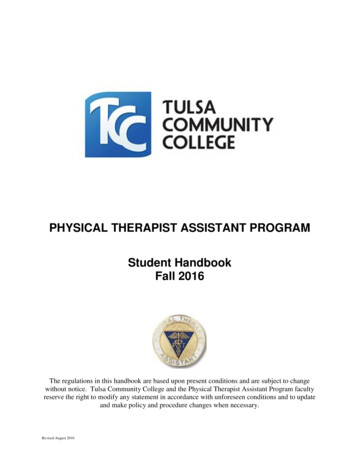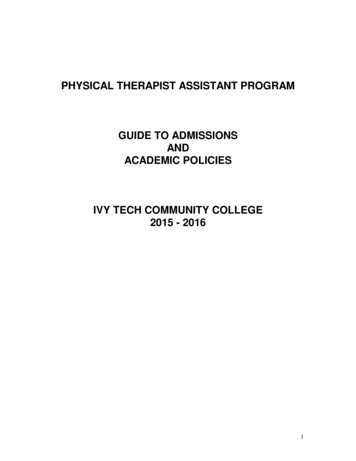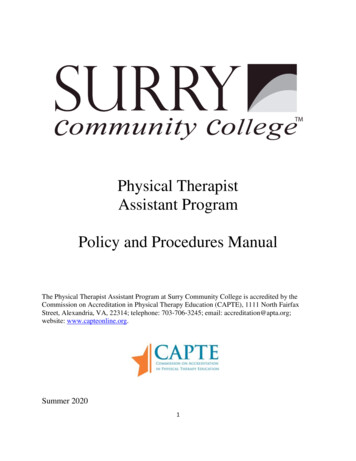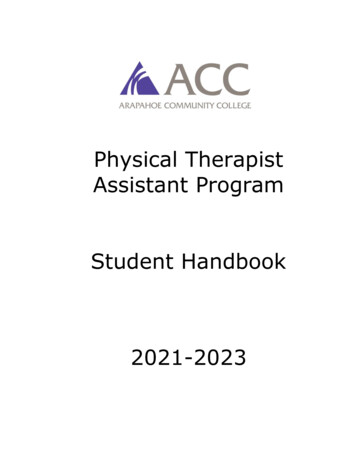
Transcription
Physical TherapistAssistant ProgramStudent Handbook2021-2023
TABLE OF CONTENTSWelcome .1Accreditation .2Non-Discrimination.2ADA Statement .2DEFINITION & FUNCTION OF A PHYSICAL THERAPIST ASSISTANTRole and Function of a Physical Therapist Assistant .4Job Outlook .7PTA Program Graduate Outlook .7PROGRAM POLICIESMission of the PTA Program .9Health Care.10Arapahoe Community College Sexual Misconduct and Title IX .12Off-Campus Learning Experiences .13Use of Academic Facilities .14Drugs/Alcohol/Tobacco .15Leave of Absence .16Probationary Status .18Program Dismissal .18Grievance Procedures.20Student Academic Support.21STUDENT POLICIESStudent Rights .24Student Ethics.24APTA Standards of Conduct for the PTA.26Professional Behavior in Labs.28EDUCATION OF THE PTA AT ARAPAHOE COMMUNITY COLLEGEEducation of the Associate Degree PTA .30Professional Behaviors/Generic Abilities .30Collaborative Learning.31Professional Behaviors .32PTA CURRICULUMPTA Licensing Disclosure .60PTA Competencies. 61Financial Responsibilities .63Curriculum Sequence .64Portfolio Information.65Proposed Text List .72Evaluation Procedures .73Attendance/Tardy Policy .75Assessment Policies .76PROFESSIONAL ORGANIZATIONSProfessional Organizations . 79Student Agreement .80
WELCOMEDear Physical Therapist Assistant StudentWe congratulate you on your admission to the P.T.A. program! We recognize your dedication to yourfuture career as well as the challenges you will meet along the way. Over the next two years you willlearn more than you ever imagined, gain unforgettable experiences, develop new skills and make lifetimefriends. The PTA faculty is here to assist you along the way. We encourage you to come to us foranswers to questions, to discuss concerns, desires, and goals or just to talk.This handbook is designed to serve you throughout the program. It hopefully will be an informationalresource for the PTA program. However, you should always feel comfortable in asking any questions ofthe PTA program faculty.The faculty looks forward to having you as a Student Physical Therapist Assistant. We know that togetheryou will graduate a competent, qualified P.T.A. who will be able to provide quality patient care, practiceethically, and be an asset to the profession of physical therapy, making a difference in the lives of yourclients and contributing to the outstanding reputation of the PTA program here at ACC.Good luck as you continue down the path toward becoming a Physical Therapist Assistant.Paula Provence, PTPTA Program Chair(303) 797-5897paula.provence@arapahoe.eduAshley Vasquez, PTPTA Program is GainesPTA Program Faculty303 797 – 5827Alexis.gaines@arapahoe.edu1
ACCREDITATIONArapahoe Community College is fully accredited by the North Central Association of Colleges andSchools, 30 N. LaSalle Street, Suite 2400, Chicago, IL 60602, 800-621-7440. The Physical TherapistAssistant Program is accredited by the Commission on Accreditation in Physical Therapy Education(CAPTE) of the American Physical Therapy Association, 3030 Potomac Ave., Suite 100, Alexandria,VA 22305 800-999-2782.NON-DISCRIMINATION STATEMENTArapahoe Community College prohibits all forms of discrimination and harassment including those thatviolate federal and state law or the State Board for Community Colleges and Occupational Education BoardPolicies 3-120 and 19-60. The College does not discriminate on the basis of sex/gender, race, color, age,creed, national or ethnic origin, physical or mental disability, veteran status, pregnancy status, religion,genetic information, gender identity, or sexual orientation in its employment practices or educationalprograms and activities. The College will take appropriate steps to ensure that the lack of English languageskills will not be a barrier to admission and participation in vocational education programs. Additionally,CTE opportunities at the College will be offered without regard to sex, race, color, national origin, anddisability.The College has a designated Angela Johnson with the responsibility to coordinate the College’s civil rightscompliance activities and grievance procedures under Titles VI and VII of the Civil Rights Act of 1964,Title IX of the Education Amendments of 1972, Section 504 of the Rehabilitation Act of 1973, and Title IIof the Americans with Disabilities Act.If you have any questions, please contact Angela Johnson at 5900 S. Santa Fe Drive, Littleton, CO 80120,telephone 303.797.5715, email S FOR STUDENTS WITH DISABILITIESRequests for academic accommodations can be made by contacting the Student Access Services Office at303.797.5730.Accommodations for student activities and events will be provided upon request. Persons with disabilitieswho require an accommodation to participate in a student activity should notify the Student Life Office(303.797.5668) at least three working days prior to the event.Inquiries or specific complaints of alleged disability-related discrimination or harassment should contactthe Human Resources Director, Angela Johnson (303.797.5715), Arapahoe Community College, 5900 S.Santa Fe Drive, Littleton, CO 80120.Any student eligible for and needing academic adjustments or accommodations because of a disabilityshould inform the PTA Program Chair prior to the first week of attending the program. A copy of theletter of accommodation must be presented to the Program Chair and instructors at the beginning of eachsemester.2
DEFINITION & FUNCTIONOF A PHYSICALTHERAPIST ASSISTANT3
ROLE AND FUNCTION OF A PHYSICALTHERAPIST ASSISTANTThe role, function and utilization of a Physical Therapist Assistant are defined by the professionalorganization, American Physical Therapy Association (APTA), state of Colorado Practice Act, andinsurance providers including Medicare. Physical therapy providers are responsible to be aware of all areasthat regulate the delivery of physical therapy services which includes the afore mentioned entities and thepatient’s individual insurance providers.DIRECTION AND SUPERVISION OF THE PHYSICAL THERAPIST ASSISTANT HOD P06‐18‐28‐35[Amended: HOD P06‐05‐18‐ 26; HOD 06‐00‐16‐27; HOD 06‐99‐07‐11; HOD 06‐96‐30‐42; HOD 06‐95‐11‐06; HOD 06‐93‐08‐09; HOD 06‐85‐20‐41;Initial: HOD 06‐84‐16‐72/HOD 06‐78‐22‐61/HOD 06‐77‐19‐37] [Position]Physical therapist practice and the practice of physical therapy are synonymous. Both phrases are inclusiveof patient and client management, and direction and supervision. Direction and supervision apply to thephysical therapist assistant, who is the only individual who assists a physical therapist in practice. Theutilization of other support personnel, whether in the performance of tasks or clerical activities, relates to theefficient operation of the physical therapy service.Physical therapists are responsible for providing safe, accessible, cost‐effective, and evidence‐based services.Services are rendered directly by the physical therapist and with responsible utilization of physical therapistassistants. The physical therapist's practice responsibility for patient and client management includesexamination, evaluation, diagnosis, prognosis, intervention, and outcomes. Physical therapist assistants maybe appropriately utilized in components of intervention and in collection of selected examination andoutcomes data.Direction and supervision are essential in the provision of quality physical therapist services. The degree ofdirection and supervision necessary for ensuring quality physical therapist services is dependent upon manyfactors, including the education, experiences, and responsibilities of the parties involved, as well as theorganizational structure where physical therapist services are provided.Regardless of the setting in which the physical therapist service is provided, the following responsibilities mustbe borne solely by the physical therapist:1. Interpretation of referrals when available2. Evaluation, diagnosis, and prognosis3. Development or modification of a plan of care, which is based on the initial examination or reexamination andincludes the physical therapy goals and outcomes4. Determination of when the expertise and decision‐making capability of the physical therapist requires the physicaltherapist to personally render services and when it may be appropriate to utilize the physical therapist assistant5. Revision of the plan of care when indicated6. Conclusion of an episode of care7. Responsibility for any “hand off” communication8. Oversight of all documentation for services rendered to each patient or clientOnly the physical therapist performs the initial examination and reexamination of the patient and mayutilize the physical therapist assistant in collection of selected examination and outcomes data.The physical therapist is responsible for services provided when the physical therapist’s plan of care involves the physicaltherapist assistant. Regardless of the setting in which the service is provided, the determination to utilize physical therapistassistants requires the education, expertise, and professional judgment of a physical therapist as described by theStandards of Practice for Physical Therapy, the Code of Ethics for the Physical Therapist, and the APTA Guide for4Professional Conduct.
In determining the appropriate extent of assistance from the physical therapist assistant, the physicaltherapist considers: The physical therapist assistant’s education, training, experience, and skill level Patient or client criticality, acuity, stability, and complexityThe predictability of the consequencesThe setting in which the care is being deliveredFederal and state statutesLiability and risk management concernsThe mission of physical therapist services for the settingThe needed frequency of reexaminationPhysical Therapist AssistantDefinitionThe physical therapist assistant assists the physical therapist in the provision of physical therapy. The physicaltherapist assistant is a graduate of a physical therapist assistant program accredited by the Commission onAccreditation in Physical Therapy Education.UtilizationThe physical therapist is directly responsible for the actions of the physical therapist assistant in all practicesettings. The physical therapist assistant may provide services under the direction and at least generalsupervision of the physical therapist. In general supervision, the physical therapist is not required to be on sitefor direction and supervision but must be available at least by telecommunication. The ability of the physicaltherapist assistant to provide services shall be assessed on an ongoing basis by the supervising physicaltherapist.Services provided by the physical therapist assistant must be consistent with safe and legal physical therapistpractice and shall be predicated on the following factors: complexity and acuity of the patient’s or client’sneeds; proximity and accessibility to the physical therapist; supervision available in the event of emergenciesor critical events; and type of setting in which the service is provided. The physical therapist assistant makesmodifications to elements of the intervention either to progress the patient or client as directed by the physicaltherapist or to ensure patient or client safety and comfort. When supervising the physical therapist assistant in any offsite setting, the following requirements must beobserved:A physical therapist must be accessible by telecommunication to the physical therapist assistant at all times while thephysical therapist assistant is providing services to patients and clients.There must be regularly scheduled and documented conferences with the physical therapist assistant regarding patientsand clients, the frequency of which is determined by the needs of the patient or client and the needs of the physicaltherapist assistant.In situations in which a physical therapist assistant is involved in the care of a patient or client, a supervisory visit by thephysical therapist: Shall be made upon the physical therapist assistant's request for a reexamination, when a change in the planof care is needed, prior to any planned conclusion of the episode of care, and in response to a change in thepatient’s or client’s medical status Shall be made at least once a month, or at a higher frequency when established by the physical therapist,in accordance with the needs of the patient or client Shall include: An onsite reexamination of the patient or client Onsite review of the plan of care with appropriate revision or termination Evaluation of need and recommendation for utilization of outside resources 5
DEFINITION AND UTILIZATIONOF THE PHYSICAL THERAPIST ASSISTANT(State of apy/As of June 1, 2012, PTAs in Colorado have been required to have state certification. InColorado PTAs are allowed off-site supervision but may not provide clinical supervision forother unlicensed personnel when the PT is not on site. By law a Physical Therapist Assistant canonly practice physical therapy under the supervision of a physical therapist.According to the Colorado Practice Act a licensed PT must be on the premise when a studentPTA is involved in patient care. A PTA student is not counted in the 1:4 ratio of licensed PTs toindividuals who are not PTs assisting in the practice.MEDICARE REQUIREMENTSPhysical therapist assistants can render physical therapy services under the Medicare Programwithout the qualified physical therapist being on the premises (except for privately ownedphysical therapy clinics) as long as the physical therapist assistant meets certain qualificationsand certain supervisory requirements are met. The service must, in fact, be performed by orunder the supervision of a qualified physical therapist; i.e., the qualified physical therapistprovides authoritative procedural guidance or the rendering of the services with initial directionand periodic inspection of the actual act. Periodic inspection is required at least once every 30days.Medicare reimburses for physical therapy when the services are provided by a recognizedprovider (PT and/or PTA). Medicare does NOT reimburse for student minutes for physicaltherapy. Therefore, a physical therapist must be present and in line-of-sight with a PTA studentto legally seek and receive reimbursement.As of January 2010, Medicare’s definition of a qualified PTA practitioner requires that PTAs whograduated from an accredited PTA program in or after 2008, will also have to have successfullycompleted the National PTA examination to request reimbursement for care of Medicarebeneficiaries.JOB OUTLOOKEmployment in the Health services is one of the largest industries and includes 11 million jobs.The top 20 fastest growing occupations includes nine in the health services area with most of thejobs requiring less than 4 years of education beyond high school.Employment of physical therapist assistants is expected to grow much faster than the average.Despite reimbursement limits imposed by federal legislation, the demand for physical therapistassistants will continue to rise, with growth in the number of individuals with disabilities orlimited function including the rapidly growing elderly population. Additionally, future medicaldevelopments should permit an increased percentage of trauma victims to survive, creating6
added demand for therapy services. Licensed/certified physical therapist assistants can enhancethe cost- effective provision of physical therapy services by providing physical therapy afterthe patient has been evaluated. Median annual earnings of physical therapist assistants were 59,440 in 2020, (http://www.bls.gov/oes/current/oes312021.htm).PTA PROGRAM GRADUATE OUTLOOKLocally, graduates from Arapahoe Community College PTA Program have been employed innursing homes, hospitals, school systems, home health and outpatient facilities. Placement ratefor the 2014- 2019 PTA graduates is 100%. Beginning June 1, 2012 PTA employment inColorado requires certification of PTAs which includes successful completion of the NationalPhysical Therapist Assistant exam after graduation. The National PTA Exam ultimate pass ratefor graduates of the ACC PTA Program is consistently over 90% and often is 100%.7
PROGRAM POLICIES8
VISION AND MISSION OF THE PTA PROGRAMVISION STATEMENTThe Physical Therapist Assistant Program’s vision is to be Colorado’s recognized leader inphysical therapist assistant education through flexibility and innovation in all aspects of ourprogram including recruitment, admissions, and classroom and clinical education. We willdedicate our expertise and resources to the delivery of PTA education in ways which recognizethe diversity, experience and needs of our students as well as the level of competence andexcellence required of entry level PTAs by Colorado’s physical therapy community.MISSION STATEMENTThe Physical Therapist Assistant program provides physical therapist assistant education to awidely diverse student clientele. Since the educational needs of the program’s constituency varysignificantly, the program is committed to maintaining instructional flexibility to provide forthese diverse needs; it encourages lifelong learning.The Physical Therapist Assistant program fosters a sense of personal and professional integrity,ethics and responsibility, and understanding of the critical thinking and problem-solvingprocesses; it develops communication skills and promotes an awareness and acceptance ofindividuals and groups from various backgrounds. The physical therapist assistant program’scommitment to this educational process will prepare students with the medical knowledge,clinical skills, and professional behaviors necessary to meet the challenges inherent within ourcomplex, evolving systems of physical therapy and health care delivery. Our graduates will beknowledgeable, competent, self-assured, adaptable, compassionate, and service-oriented physicaltherapist assistants capable of competently performing the duties of a PTA in a variety of PTsettings.The Physical Therapist Assistant program responds to our physical therapy community includingefforts to advance the recognition of the field of physical therapy and the role of PTAs within thefield. We partner with area clinicians and facilities to determine and meet their needs for physicaltherapist assistants.PhilosophyThe PTA Program at Arapahoe Community College reflects belief in fostering dignity, selfworth, integrity, teamwork, and professional growth while pursuing a problem-solving approachto effectively deal with the dynamics of providing health care.PTA Program Goals and ObjectivesThe goal of the PTA program is to prepare our graduates to assume a responsible position in the PhysicalTherapy community, delivering consistently high-quality services to patients/clients under the direction ofand seeking consultation from the physical therapist. Additionally, the PTA program seeks to: Produce graduate PTAs prepared to competently perform the duties of a PTA in a variety of PTsettings, Produce graduate PTAs prepared to successfully complete the national licensure examination andobtain licensure/certification in the state of their choice, Produce graduate PTAs prepared with a technological proficiency to effectively participate in theever-evolving practice of Physical Therapy, and Advance community recognition of the field of physical therapy and the role of PTAs within thefield.9
HEALTH CAREThe PTA program at Arapahoe Community College does not provide health insurance forstudents. A low-cost health insurance plan is available through the APTA for student members.If an injury occurs during internships, the facility will provide emergency care with expensesbeing covered by Workmen’s Compensation through ACC. It is the student's responsibility toimmediately notify the PTA Program Chair/ACCE of work-related injury.It is the student's responsibility to report any significant health care problems and the taking ofprescription medication to the PTA Program Chair and, when appropriate, to his/her clinicalsupervisor. The reporting of any change in the student’s health status including pregnancy ortaking of prescription drugs will not jeopardize the student in the PTA Program but rather assistin planning and providing safe educational and clinical experiences. Any physical limitations orrecent change in physical status including hospitalization must be documented by a physician inwriting. A written statement from the physician must be presented to the Chair when limitationsare removed or discharged from the hospital before a student may resume participating in class,labs, and/or internships.Students, at their own expense, will be required to prove current immunizations, complete abackground check, and drug screening before placement in internships. Students will be orientedto blood borne pathogens, fire and electrical safety, and HIPPA standards annually. Students willbe provided with specific directions, cost and other information, forms, and/or waivers duringinternship orientation.IF YOU SUSPECT YOU'VE BEEN EXPOSED TO HIV - AIDSThe following are guidelines for exposure to blood or other potentially infectious body fluids.The Center for Disease Control defines "exposure" as direct contact-- via percutaneousinoculation, an open wound, non-intact skin, or a mucous membrane--with blood, certain otherbody fluids (amniotic, pericardial, peritoneal, pleural, synovial, and cerebrospinal fluids; semen;vaginal secretions), or any body fluid visibly contaminated with blood (MMWR38(S-6):9-10).The CDC advises that you be clinically evaluated and serologically tested for evidence of HIV orAids infection as soon as possible after the exposure.The Public Health Service recommends these actions: report "any acute febrile illness thatoccurs within 12 weeks of the exposure. Such an illness, particularly one characterized by fever,rash, or lymphadenopathy, may be indicative of recent HIV infection" (MMWR38(S-6):13).If your test at the time of exposure is negative, seek repeat testing 6 weeks, 12 weeks, and 6months later to see if transmission has occurred. Most people who are infected, seroconvert 6 to12 weeks after exposure.If the person to whom you were exposed is tested and is found to be seronegative, you may stillwant to obtain baseline testing with follow-up testing 12 weeks later.10
INJURY POLICYStudents are covered by Workers’ Compensation while in an assigned clinical setting. In the event of an injurythe student must do the following:At the Clinical Site:1. Report the incident to his/her clinical instructor.2. Follow through with the facility’s requirements for on-site treatment and documentation. Provide a copy ofthe facility’s documentation to ACC Human Resources Office. Follow-up care must be provided by ACCWorkers’ Compensation providers as listed below.3. Check patient/client chart for history of Hepatitis B or any other communicable disease (if appropriate).At ACC:1. Report to the Human Resources Office, ACC Church Street Building, 797-5741 within 48 hours of incident.2. Bring copies of the facility’s report and any billings related to treatment.3. Complete Workers’ Compensation claim form, available from the Human Resources Office.4. Arrange follow-up care through the ACC Human Resources Office:a) Human Resources will contact Concentra to either let hospital personnel know that you are on your wayor to make an appointment for you.b) Upon treatment from Concentra, submit the necessary paperwork back to the Human Resources Officefor further processing no later than 72 hours after the incident.Care Providers for Work-Related Injuries & IllnessesAny work-related injury that is not life-threatening and occurs during standard work hours, requires that youfirst contact Human Resources at 303.797.5741 or askHR@arapahoe.edu prior to seeking medical attention.Medical care, during standard clinic hours, for work-related injuries is provided at HealthOne/CareNow clinicsor Concentra clinics. If an injury is life-threatening, proceed immediately to the nearest emergency roomor dial 911.During Standard Clinic Hours:CareNow Urgent Care20 W Dry Creek Cir #1009330 S University Blvd Ste 100Littleton, 80120Highlands Ranch, 80126(303) 798-1009(303) 346-3627Concentra Health5990 S University Blvd7120 E County Line RdGreenwood Village, 80121Highlands Ranch, 80126(720) 446-5890(720) 446-5891After Hours Care:Littleton Adventist Hospital7700 S Broadway, Littleton, 80122(303) 730-5800Note: You may be liable for all medical bills if you choose your own doctor for treatment of a workrelated injury.11
*It is important to note that the student should not be driven to the hospital or Concentra byanother individual (for liability reasons). If they are unable to drive themselves, an ambulanceshould be called to take them for treatment.Also – the student shouldn’t return to clinical until released by Concentra. For return to clinical,the student must be released without restrictions. Both the clinical facility and the PTA programdirector must be kept updated on student’s status.Sexual Misconduct and Title IXThe ACC community has the right to be free from sexual violence. All members of the ACCcommunity are expect
insurance providers including Medicare. Physical therapy providers are responsible to be aware of all areas . physical therapist assistant, who is the only individual who assists a physical therapist in practice. The . Liability and risk management concerns The mission of physical therapist services for the setting
